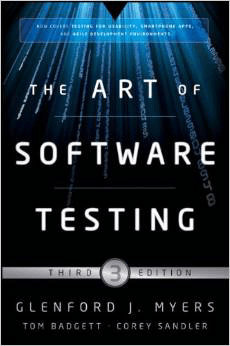
“The Art of Software Testing”” by Glenford J. Myers, Tom Badgett and Corey Sandler is one of my favorite books concerning testing and software engineering in general. In this article, I will provide an overview of the book, as well as highlight the ideas and quotes that I found to be the most interesting.
There were three editions of the book. The first one was published in 1979, when I was just too young to appreciate it. The second one was published in 2004—I read it first in 2007. The third one was published just two years ago, in 2012. I bought this edition also, and read it like it was my first time. This book is still one of the top books in the software testing domain, despite its age and some content that is rather out-dated.
Out-dated Content
First, let’s filter out what is not worth reading (in my opinion).
There are eleven chapters, but you can easily skim through nine of them. This is because those chapter discuss concepts that are discussed elsewhere in the book with a more robust level of detail or on a much higher level of abstraction.
For example, Chapter 3 contains an eleven-page checklist to be used by a code reviewer in order to find programming mistakes. This list is definitely not comprehensive and it can’t compete with, say, “Code Complete” by Steve McConnell. I believe, this checklist had significant value twenty years ago, but now it is out of date.
Chapter 5 discusses basic principles and strategies of unit testing. However, the discussion is not abstract enough for a short 25-page summary, and is not specific enough for a detailed discussion. Again, twenty years ago this information may have had some value. Nowadays, “Growing Object-Oriented Software, Guided by Tests” by Steven Freeman and Nat Pryce is a much better source for this subject.
There are also articles about usability testing, debugging, web application testing, and mobile testing. Here we have the same issue—they are not abstract enough and they are much too outdated to be relevant to the current issues in software testing. I would recommend readers to briefly skim those subjects for background information, but to not read too much into it.
Psychology of Testing
The most important and valuable part of the book is Chapter 2. It is full of priceless quotes that can also be very practical. For example, on page 6:
Testing is a destructive, even sadistic, process, which explains why most people find it difficult

In Chapter 2, Dr. Myers discusses the psychology of testing and a very common and crucial misunderstanding of testing objectives. He claims that it is commonly accepted that the goal of software testing is “to show that a program performs its intended functions correctly” (p.5). Testers are hired to check whether the software functions as expected. They then report back to management whether all tests have successfully passed and whether the program can be delivered to end users.
Despite the plethora of software testing tomes available on the market today, many developers seem to have an attitude that is counter to extensive testing
This is what Dr. Myers says on the second page, and I can humbly confirm that in all software groups I’ve been worked in thus far, almost everyone, including testers, project managers, and programmers, share this philosophy. They all believe that “testing is the process of demonstrating that errors are not present” (p.5)
However, “these definitions are upside down” (p.6). The psychology of testing should be viewed as the opposite. There are two quotes that support this theory and I feel that they make the entire book.
The first one, on page 6, defines the goal of software testing:
Testing is the process of executing a program with the intent of finding errors
The second one, on the following page, further refines the first goal:
An unsuccessful test case is one that causes a program to produce the correct results without finding any errors
Dr. Myers comes back to these two thoughts in every chapter. He reiterates over and over again that we should change the underlying psychology of how we view testing, in order to change our testing results. We should focus on breaking the software instead of confirming that it works. Because testing is a “sadistic process” (p.6) of breaking things. It is a “destructive process” (p.8).
If you read Chapter2 very carefully and truly understand its underlying ideas, it may change your entire life. This chapter should be a New Testament of every tester.
Test Completion Criteria
In Chapter 2, Dr. Myers also mentions that a program, no matter how simple, contains an unlimited number of errors. He says that “you cannot test a program to guarantee that it is error free” (p.10) and that “it is impractical, often impossible, to find all the errors in a program” (p.8).
Furthermore, at the end of Chapter 6, he makes an important observation (p.135):
One of the most difficult questions to answer when testing a program is determining when to stop, since there is no way of knowing if the error just detected is the last remaining error
The problem is obvious. Since any program contains an unlimited number of errors, it doesn’t matter how long we test, we won’t find all of them. So when do we stop? What goals do we set for our testers? And even more importantly, when do we pay them and how much (this question is important to me since I only work with contractors and am required to define measurable and achievable goals)?
The answer Dr. Myers gives is brilliant (p.136):
Since the goal of testing is to find errors, why not make the completion criterion the detection of some predefined number of errors?
He then goes on to discuss exactly how this “predefined number” can be estimated. I find this idea very interesting. I have even applied it to a few projects I’ve had in the last few years. It works. However it can also cause serious psychological problems for the team. Most people simply resent the goal of “testing until you find a required number of bugs.” The most common response is “what if there are no bugs any more?.”
However, after a few fights, the team eventually begins to appreciate the concept and get used to it. So, I can humbly confirm that Dr. Myers is right in his suggestion. You can successful plan testing based on a predefined number of errors.
Summary
I consider this book a fundamental writing in the area of software testing. This is mostly due to Chapter 2 of the book. In fact, there are just three pages of text that build the foundation of the entire book. They are the skeleton of the other two hundred pages.
Unfortunately, since 1979, this skeleton hasn’t become the backbone of the software testing industry. Most of us are still working against these principles.
